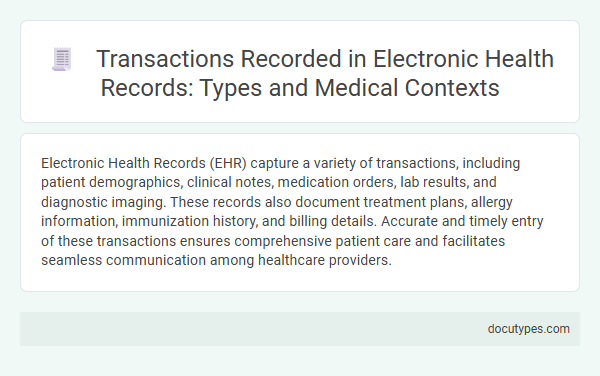Electronic Health Records (EHR) capture a variety of transactions, including patient demographics, clinical notes, medication orders, lab results, and diagnostic imaging. These records also document treatment plans, allergy information, immunization history, and billing details. Accurate and timely entry of these transactions ensures comprehensive patient care and facilitates seamless communication among healthcare providers.
Overview of Electronic Health Records (EHRs) and Transaction Logging
Electronic Health Records (EHRs) are digital versions of patients' medical histories, enabling healthcare providers to access comprehensive clinical data efficiently. EHRs include details such as patient demographics, medical conditions, treatment plans, medications, and laboratory results.
Transaction logging in EHRs captures all interactions within the system, including data entry, updates, and access by authorized personnel. This process ensures data integrity, supports audit trails, and enhances the security and accountability of medical information management.
Types of Transactions Recorded in EHR Systems
What kinds of transactions are entered in Electronic Health Records (EHR)? EHR systems record various types of transactions including patient demographics, clinical notes, diagnostic test results, medication orders, and billing information. These transactions ensure comprehensive documentation of patient care and streamline healthcare delivery.
Clinical Documentation and Patient Encounter Records
Electronic Health Records (EHR) primarily include clinical documentation that captures detailed patient encounter records. These transactions consist of physician notes, diagnostic test results, medication orders, and treatment plans entered during patient visits. Accurate recording of these data ensures comprehensive patient history and aids in effective clinical decision-making.
Medication Orders and Prescription Management Transactions
Electronic Health Records (EHR) streamline the management of medication orders and prescriptions through precise digital entries. These transactions enhance patient safety, ensure accurate dosing, and facilitate efficient communication among healthcare providers.
- Medication Orders - Digital entries specifying drug name, dosage, frequency, and route for patient treatment.
- Prescription Management - Electronic processing and tracking of prescriptions to prevent errors and verify patient compliance.
- Clinical Decision Support Integration - Automated alerts for potential drug interactions, allergies, and contraindications during order entry.
Laboratory and Diagnostic Test Reporting Transactions
Electronic Health Records (EHR) capture various types of transactions, with laboratory and diagnostic test reporting being critical for patient care. These transactions include the input of test orders, receipt of test results, and integration of diagnostic imaging reports. Timely and accurate recording of these data supports clinical decision-making and enhances patient outcomes.
Procedures and Treatment Documentation in EHRs
Electronic Health Records (EHR) include detailed entries of medical procedures and treatment documentation essential for comprehensive patient care. These records ensure accurate tracking and coordination of healthcare services provided to you.
- Procedures Performed - Documentation of all diagnostic, therapeutic, and surgical procedures carried out during a patient encounter.
- Treatment Plans - Detailed descriptions of prescribed treatment protocols, including medications, therapies, and follow-up care.
- Clinical Notes - Physician and healthcare provider notes that describe the rationale, progress, and outcomes of treatments administered.
Complete and precise records in EHRs support effective communication among healthcare providers and improve patient safety.
Patient Admission, Transfer, and Discharge Transactions
Electronic Health Records (EHR) capture critical transactions related to patient movement within healthcare facilities. These transactions ensure accurate and timely updates of patient status, improving care coordination and medical decision-making.
- Patient Admission - This transaction records details when a patient is first admitted, including personal information, medical history, and initial diagnosis.
- Patient Transfer - Transfers document the movement of a patient between departments or facilities, capturing updated location and clinical information to maintain continuity of care.
- Patient Discharge - Discharge transactions summarize the patient's hospital stay, treatment outcomes, and follow-up instructions essential for ongoing care management.
Your healthcare providers rely on accurate EHR transactions to deliver effective and personalized treatment throughout your care journey.
Billing, Coding, and Insurance Documentation Transactions
Electronic Health Records (EHR) capture vital billing transactions, ensuring accurate patient charges are recorded for medical services rendered. These transactions include itemized service fees, payment details, and patient account balances.
Coding transactions in EHR involve the use of standardized medical codes such as ICD-10 and CPT to document diagnoses and procedures. Insurance documentation transactions verify patient coverage, submit claims, and track reimbursement statuses within the system.
Security, Access, and Audit Trail Transactions
| Transaction Type | Description | Importance in EHR |
|---|---|---|
| Security Transactions | Include user authentication, authorization processes, and encryption methods to protect patient data from unauthorized access or breaches. | Ensures confidentiality and integrity of sensitive health information, complies with HIPAA and other regulations. |
| Access Transactions | Document every instance of record access, including user identity, timestamp, and the specific data viewed or modified. | Supports patient privacy by tracking who accesses medical records, helps detect improper access or potential misuse. |
| Audit Trail Transactions | Comprehensive logs recording all actions taken within the EHR system such as data entry, updates, deletions, and system alerts. | Facilitates accountability, enables forensic investigations, and assists in quality control and compliance audits. |
What Kinds of Transactions Are Entered in Electronic Health Records (EHR)? Infographic

